The other day, I introduced you to another project in this year’s embroidery project rotation – this Tree of Life miniature tapestry.
Today, we’ll chat about setting it up and getting the first stitches in.
I’m going to tell you a little bit about silk gauze in general, setting up the embroidery frame, and lighting and magnification, with a few tips that will make stitching on this kind of thing a bit easier!
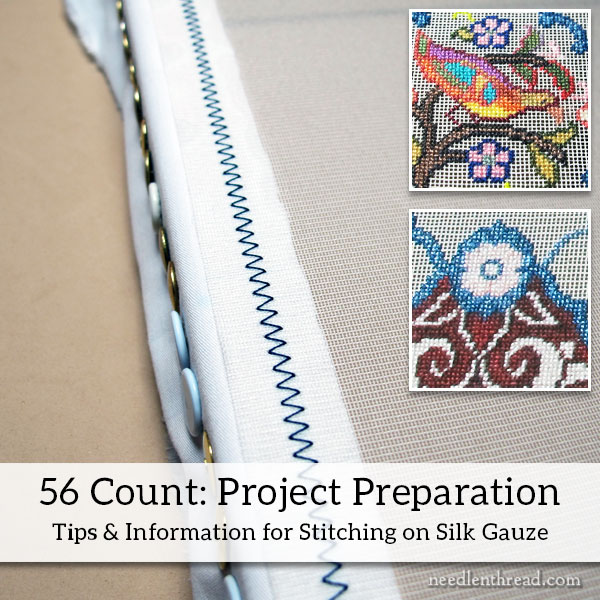
Silk gauze is funny stuff. Well, I think it’s funny, because of its name. “Gauze,” in my mind, implies something soft and limp and sheer. And “silk gauze” makes me think of light, sheer, fine silky fabric.
But that’s not what we’re talking about here!
Silk gauze in the stitching world is actually a stiff, gridded canvas (like needlepoint canvas) that’s made out of interlocking threads of silk. It is even-weave stuff, and it’s quite stiff. If you run your finger along the cut edge of silk gauze, it feels prickly and pokey.
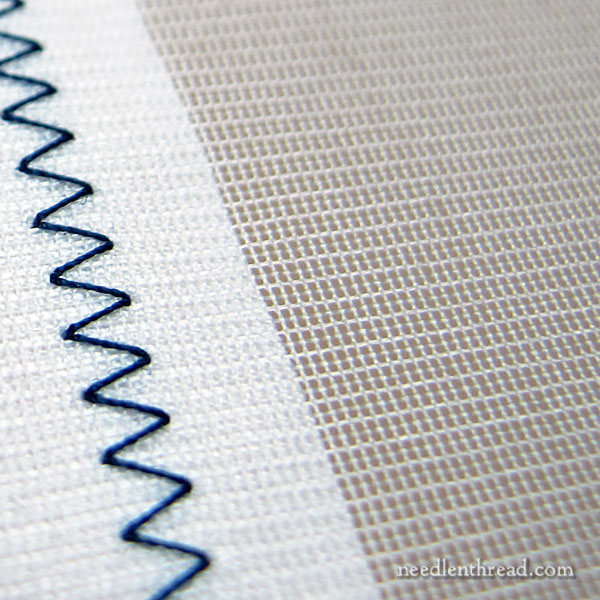
Just like other even-weave fabrics used for counted embroidery techniques, silk gauze resembles a grid. Just like mono canvas used in needlepoint, the grid features open squares.
The gauge of silk gauze is delivered in holes per inch (hpi). Depending on how fine and tiny you’re going with your stitches, silk gauze can be had in “lower” counts (like 32 count), to 40 count, 56 count, 60 count, 72 count, 90 count, and even as high as 121 count.
For tent stitching on silk gauze, up to 60 and even 72 count is a pretty reasonable proposition, with the right light and magnification. As long as you’re working with a fine enough thread (so the canvas doesn’t get tightly jammed and the grid doesn’t get distorted) with the right needle (tiny beading needles, usually), it can be done!
But I’m thinkin’ 56/60 count is about as high as I’d reasonably go!
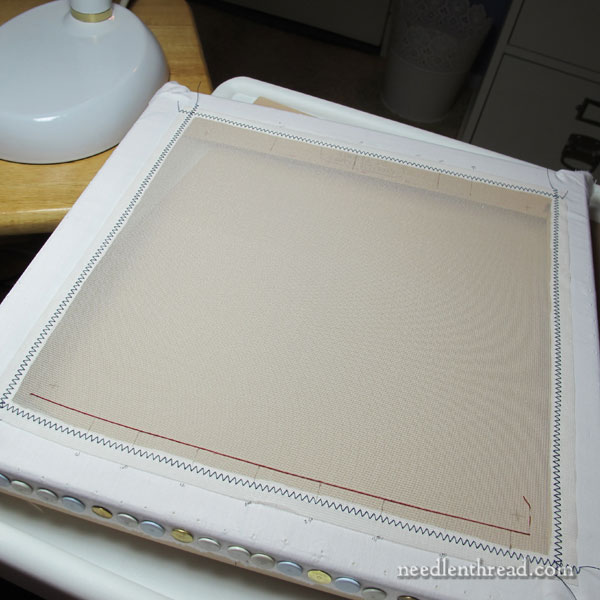
When working a larger piece on silk gauze (this one is around 7.5″ x 7.4″), the needlework needs to be set up on a frame. To set it up on a frame, the silk gauze needs to be supported by other fabric.
Mounting Silk Gauze on Fabric & a Frame
To mount the silk gauze on the supporting fabric, I stitch the silk gauze to a piece of good quality cotton, using a zig-zag stitch on the sewing machine.
The cotton should be cut large enough to fit on your embroidery frame. In this case, I’m using an 11″ x 11″ frame, but I should be using 12″ x 12″ – it would give me more room on the sides for manipulating my needle when stitching near the edges of the design.
Line up the grain of the fabric (you can read about fabric grain here) with the grid on the gauze, to make sure that your supporting fabric doesn’t go wonky on you. Anything set up on the bias of the fabric (across the grain, rather than with it) can end up stretching oddly.
Pin the silk gauze to the cotton muslin, and run it through the sewing machine, removing pins as you go. A simple zig-zag stitch works well. Stitch as close to the edge of the silk gauze as possible.
Then, when the silk gauze is attached on all sides to the supporting fabric, turn the fabric over and pull the supporting fabric away from the silk gauze. Cut a small slit in it to get your scissors started, and then carefully cut away the supporting fabric behind the silk gauze, within a couple threads of the zig-zag stitch, leaving a window of stitchable silk gauze surrounded by your supporting fabric.
When you mount the fabric onto the frame (in this case, I’m using Evertite stretcher bars – best option, in my opinion!), the tacks should go into the supporting fabric, not into the silk gauze. And preferably, the tacks should be on the side of the frame, to keep them out of the way.
You can read about setting up a project (any embroidery project – the concept is the same) on Evertite stretcher bar frames, here.
You can also read another tutorial on setting up silk gauze for stitching here, where you’ll find a few more photos of this part of the process.
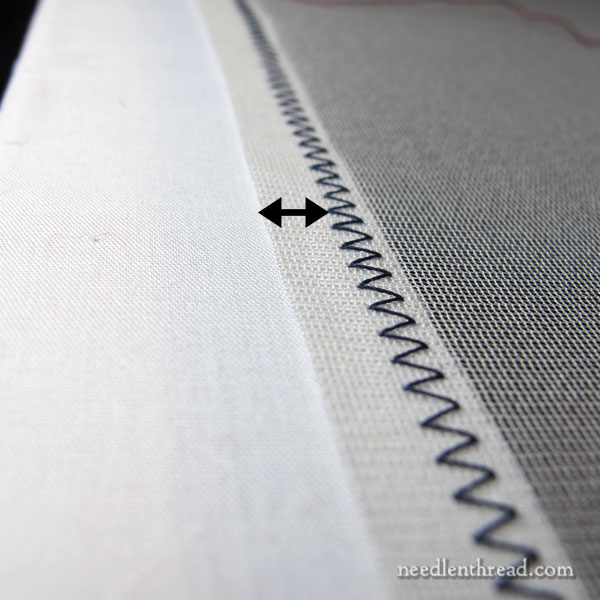
In the photo above, you can see my First Mistake!
When attaching the silk gauze to the cotton muslin, I stitched a bit farther into the silk gauze than I should have. I worked the zig-zag stitch in about 1/4″ on the silk gauze. I should have worked right to the edge of that, so that the whole zig-zag stitch fell right inside the very edge of the silk gauze. I thought that I had a good extra allowance of silk gauze for the design, but in fact, it’s not as much of an allowance as I would like!
Learn from my mistake! Stitch as close to the edge of the silk gauze as possible! This will give you more “canvas space” for stitching your design. Mine’s a little tight to the edge, but it still fits, so I left it.
Snaggy Threads
Some folks turn their silk gauze over, so that the exposed edge is on the underside of the mounting fabric, in order to minimizing threads snagging on the edge of the silk gauze as you stitch.
Trust me, the edge of the silk gauze is Snaggy Stuff! Especially when you’re working with silk embroidery thread, you want to reduce any chance of snagging!
I don’t like turning the fabric over, though, because there’s always a chance the thread will snag on the backside, too.
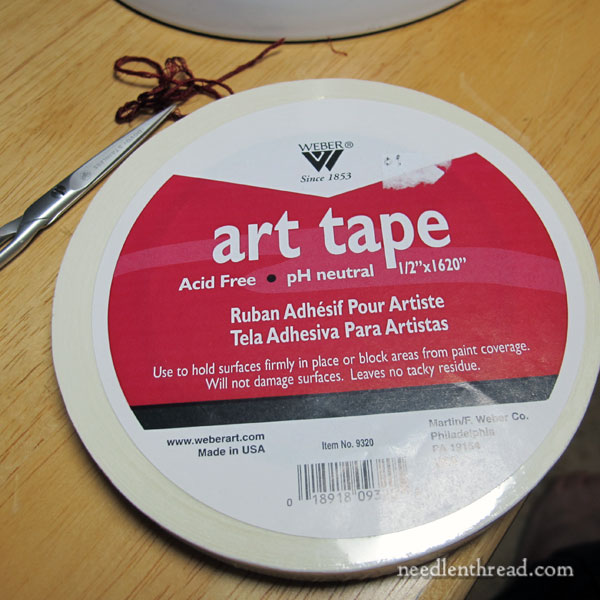
To eliminate any chance of threads snagging on the edge of the silk gauze, I use this. It’s art tape – pH neutral, no sticky residue. You can find it at most art stores, and usually in the art or painting section of hobby stores.
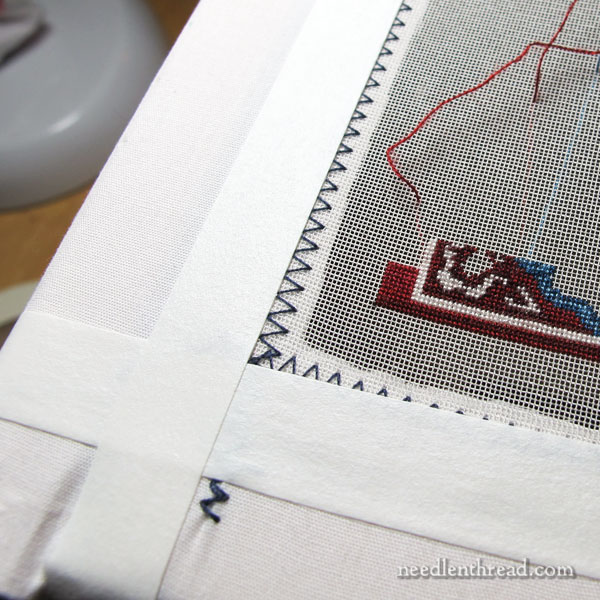
I run a length of the tape over the edge of the silk gauze all around my frame, wrapping it down the side to keep it secure – and my thread never snags! Works great!
In the photo above, you can see that I’ve started stitching! YAY!
There are probably 800 stitches in that little space already!
My Work Setting for This Project
My work setting for this project is basically this:
I use my Needlework System 4 table / lap stand to hold the frame. I find I can get the lap stand comfortably close to me, no matter what my sitting situation is. Right now, since it’s winter, and it’s cold and grey and lonely in my workroom, I want to be inside my house, where things are warmer and a little cozier. (Did I mention warmer?)
Although I have pretty rotten eyesight distance-wise, I find that, if I don’t wear my glasses, I can see the canvas just fine. I keep the work 6 – 8″ from my face as I stitch. This poses the problem of not being able to see beyond the frame, but when I’m doing this kind of work, I’m not usually doing anything else where I need immediate distance vision. So I just take my glasses off, because it’s easier than messing with any magnification devices.
I have a stitching light next to me, situated over my right side because I’m right handed. Now, this sounds backwards, but with this type of stitching, I use both hands to stitch. The right hand is below the frame, to guide the needle up into the canvas, and the left hand is above the frame, to guide the needle back down into the canvas.
Keeping the light at my right side, I don’t have a shadow from my left hand above the frame.
I have a small temporary table set up, to hold all my necessary things: supplies, stitching tools, camera, phone.
When I go on a stitching binge with this kind project, I’m usually listening to an audiobook. Anything else would require distance vision. There’s nothing I like better than listening to a good book while on a stitching binge!
Magnification & Lighting
Many of you wrote in to ask about what kind of lighting and magnification I’m using for this type of tiny stitching.
As mentioned above, I’m not using magnification. But if you need magnification, if you don’t like up-close stitching, there are many, many options out there for good magnification for needlework. I suggest something that combines light and magnification.
When I need to, I use this Dublin craft light / magnifier combination that I bought years ago. I like it! But it’s not as easily available these days, it seems.
This Brightech on Amazon looks similar, but with a larger viewing area, and it has excellent reviews. I haven’t personally tried it, but I’m thinking about trying it when the budget allows. It’s less expensive than the Dublin I mentioned above. If I ever take the plunge, I’ll let you know what I think about it.
I also have this pair of CraftOptics that I’ll use in certain situations. They’re great once you get used to them! They have an attachable lighting option, too, and are perfectly portable.
But for this particular project, I’m not using any of the above. Just my bare naked eyes!
I have a very bright BlueMax light (I reviewed those here), and it serves as my stitching lamp. If I need a more controlled or subdued lighting option (if there are other people in the room who don’t like my bright light, for example), I have a few little lights I’ve used with good success. In fact, I’ll show you some of those – and compare them – in the near future.
Next Time…
Next time we visit this project, we’ll chat a bit about needles and embroidery thread for this type of stitching.
Ahhh, yes…thread! The fun stuff!
Enjoy your weekend! Here in Kansas, we’re expecting a bit of ice – good weather to stay home and stitch!







Hi Mary,
In winter our skin gets dry. What do you use on your hands to prevent dry rough skin from snagging? Especially with delicate fabrics such as gauze, silks, etc..
I try to get a lot of stitching done in the morning using the eastern light. The best!
Hi, Pat – I’ve gotten a bunch of questions about this very topic lately, thanks to winter weather! I’m going to write a blog post on it in the coming days. I’ve got a routine that works for me, so I’ll share that and I’ll talk about other tips for major rough skin.
Hi Pat,
In New Mexico we sometimes get 10% humidity so we are always using moisturizers. I just found one that I love. It’s from Savannah Bee. Royal Jelly Body Butter for sensitive skin. It’s very thick and creamy, all natural, with just a very light scent. My hands are smoother than ever and I have just used it for a few weeks. Hope this helps! Robin
I too am quite nearsighted, and do a lot of close work and reading with my glasses off. I call it my built-in magnifying glass!
Mary, this is great timing for me as I’m about to get my first silk gauze project. If it’s smaller, say the size of the hearing tapestry, would it be better to stitch the fabric to cotton and use a round hoop, or should I stick with the frame?
I’m going to have to get a magnification lamp. Would love to just work with glasses off but I’m more nearsighted and would probably poke an eye out. It sure is great for tiny detail work, isn’t it. ….myopic stitchers unite!
Hi,Jean – I prefer a frame to a hoop, for something that’s going to take this long. It holds up better and more consistently, tension wise. Yes, I thought about the possibility of poking my eye out! 🙂 But I’m pretty careful about that! When you’re stitching with two hands (which you can do if your frame is supported by a stand), the hand on top of the frame gets to the needle before it’s too far out of the fabric, so that helps!
Thanks! I’ll plan for a frame.
I am careful when I look over my glasses to stitch, but what I meant was that I have to hold the fabric more like 2-3 inches from my face…not a lot of leeway there. 😀
I’m so anxious to hear about the type of thread you’re using. Certainly can’t be DMC cotton floss. For me, even one strand of that on 22 count gets rather bulky and getting the needle through a hole with other stitches placed around it can end up ugly. 🙂
I’m with you, I also see better close up without my glasses. I also do tatting and people constantly ask me how I can see that. Mary, How do you deal with stitching with the white threads? Do you have problems with the thread getting soiled?
Hi Mary, I went to Amazon to check out the Brightech Magnifying lamp and it is on sale. If you are a prime member it may ship free! Thanks for all your great tips. Best wishes for a great New Year.
Thanks for this posting. For years I have held onto a stash of this silk gauze not sure what to do with. I will be re-visiting this post to decide!
I enjoyed this post on setting up. I have never embroidered before although it is my goal this year. I have done a bit of cross-stitch. I am interested in how you take care of thread ends on the back. I’m working on a project with a high stitch count and lots of color changes. I find when I weave the ends in on the back it’s getting lumpy. How do you handle this? Perhaps in a post you can show us the back.
Hi, Denise – when I get to the point where the back can show us something substantial, I’ll try to remember to snap some photos! I don’t normally take photos of the back, because I don’t want people to be overly obsessive about the back of their work. Sure, it should be kept relatively neat, but it doesn’t have to look like the front! I just draw my needle and thread straight underneath a short line of stitches on the back, to hold the thread when ending it. I don’t whip around any stitches – just a straight draw through under several stitches (maybe five?). I hope that helps a little bit for now!
A surprising thing about silk gauze… the “holes” are much larger than you think. The silk threads are much, much finer than canvas or linen threads. I am loving your doing this!
FYI, Interweave.com has the Dublin lights for $129.99.
I have a magnifying lamp from Brightech, though it is one that clamps to a table rather than a floor lamp. I absolutely love it. The light is bright and doesn’t distort the colors, and the lafge lens gives a nice wide field of view for stitching. I highly recommend it!
Hi Mary,
Reading about silk gauze has made me curious. So I looked for a kit I could afford. Found one on kreinik.com. “Believe” on 40 count silk gauze 50w x 70h. It is tiny! I would never had known about this except for your site. Thank you. I am excited to get started.
Where, online, do you purchase your fabrics; e.g. silk gauze. I have a source for linens I use. I live in a small city, so online is my store, unless I want to drive two hours away. The local national chain retailers don’t carry the kind of linen I use.
Also, I use, almost exclusively 40ct linen. When have you used small count linen versus gauze?
Hi Mary
Do you know how to attach the stitched gauze to a regular 18 count needlepoint canvas? Or where to read about it?
Thanks
Cindy
Hi, Cindy – Do you want to attach it like a slip, to a lower count canvas? I think you’d have to cut it with enough of an edge around it to be able to sew it or tack it down onto the lower count canvas, and then you’d probably need to trim the excess and needlepoint up to the edge of the stitch gauze. It would require, I think, aligning the gauze with the grid of the lower count canvas as much as possible. Interesting! I’ve not done it, but that’s how I’d do it if I were going to try! There’d probably be a bit of trouble-shooting along the way…
Thank you Mary for your help. Check out Tony Minieri needlepoint artist. In his website is a piece he did with an old Asian man whose face was appliqued in gauze. It’s fabulous.
Love your work. I’ll be sharing you with my fellow stitchers!
Cindy
That face is on Pininterest under Tony Minieri
I love work that fine, to see and to do it myself. I once got fine Silk gauze but can’t find any to buy. Up to 40 count I see but 56 or finer not, do you know an address?
Looking for silk gauze for petitpont
Where can I find 56 or 60 count silk gauze. Have not been able to find it in the US. Thank you in advance.
Hi, Melissa – you might look up Natalia Franks miniatures. (Just google that.) She has a blog, but she also has a shop, and she normally carries different gauges of silk gauze.